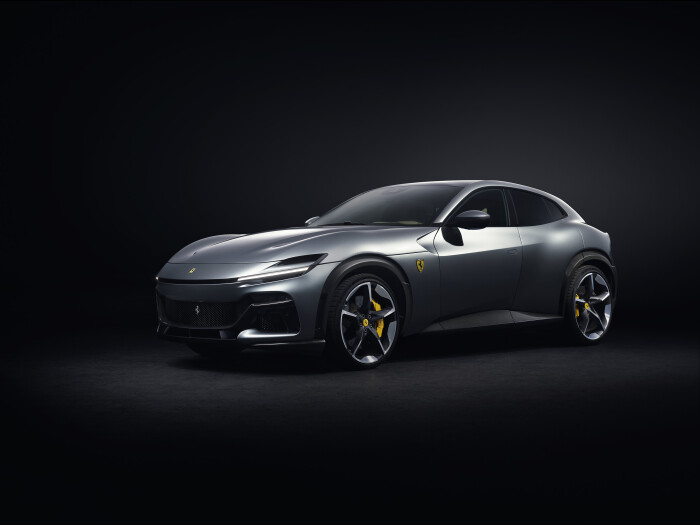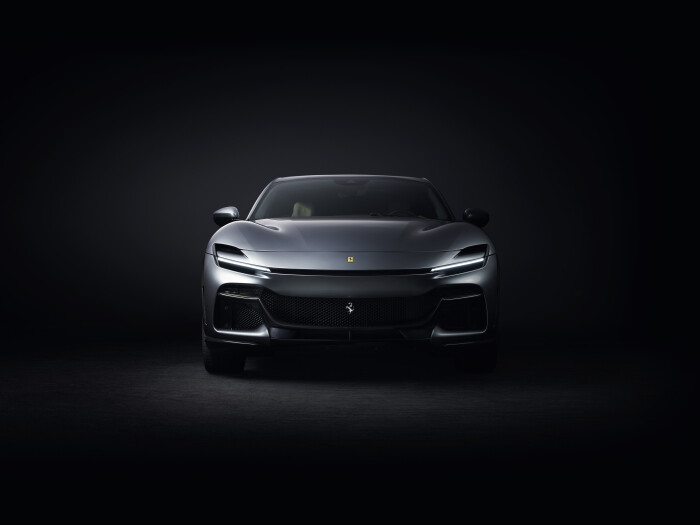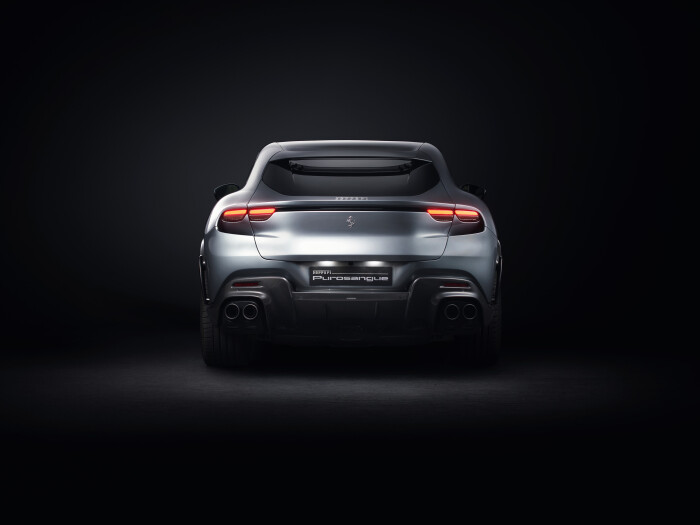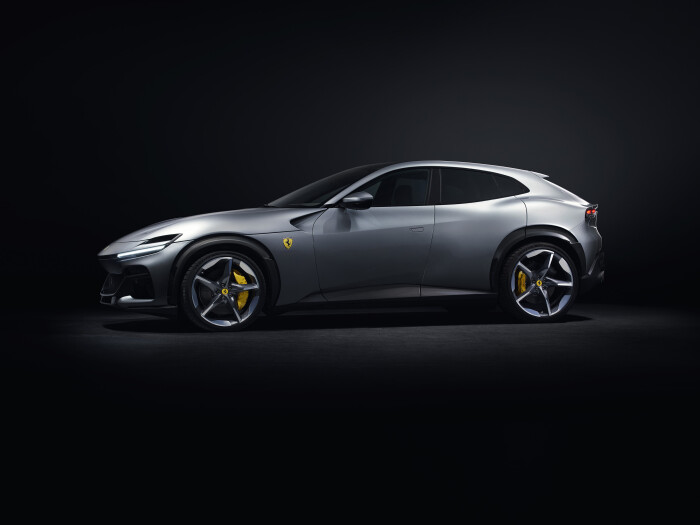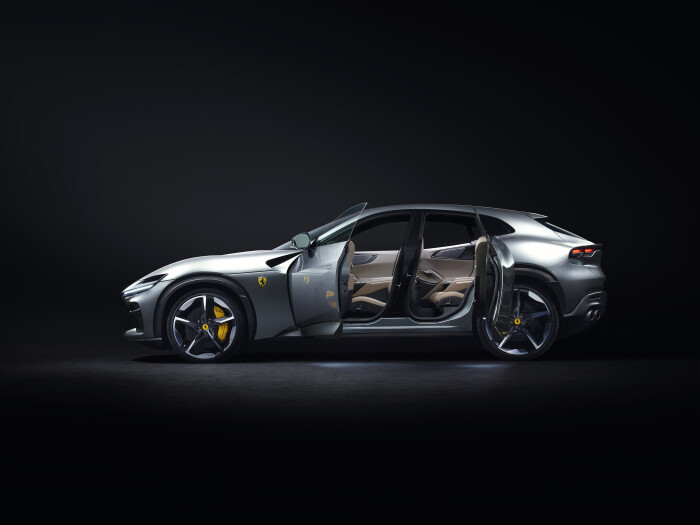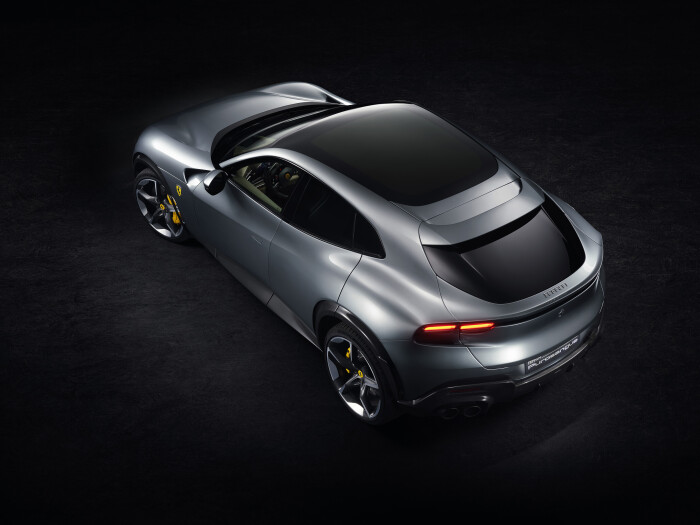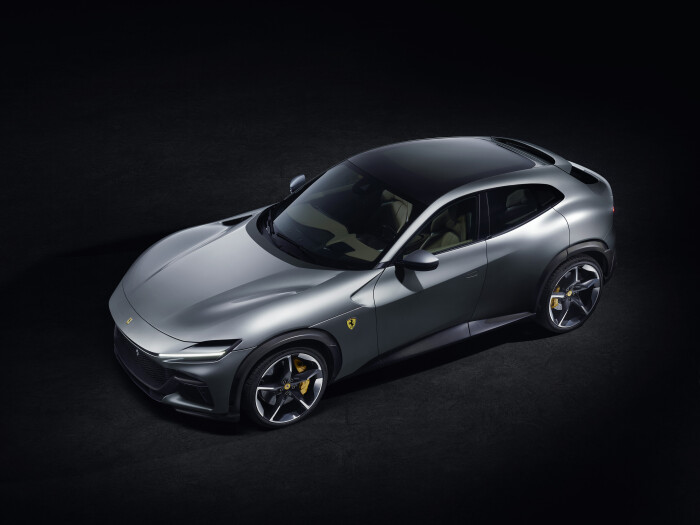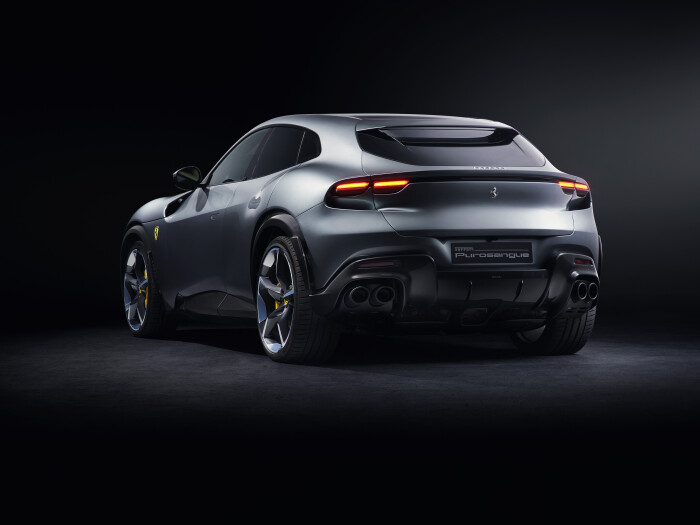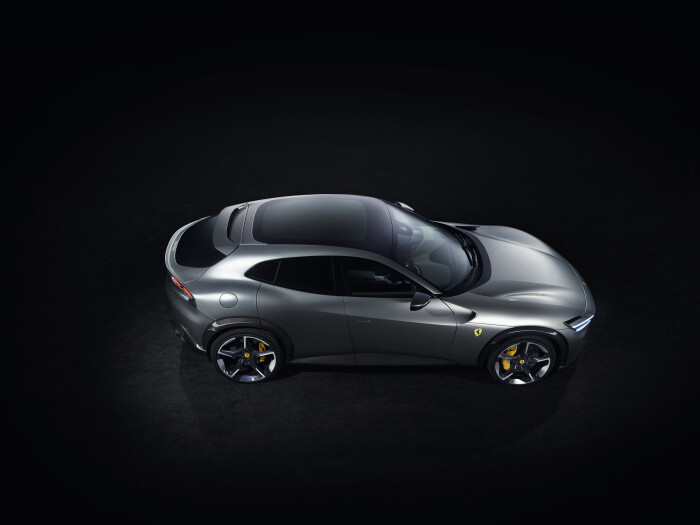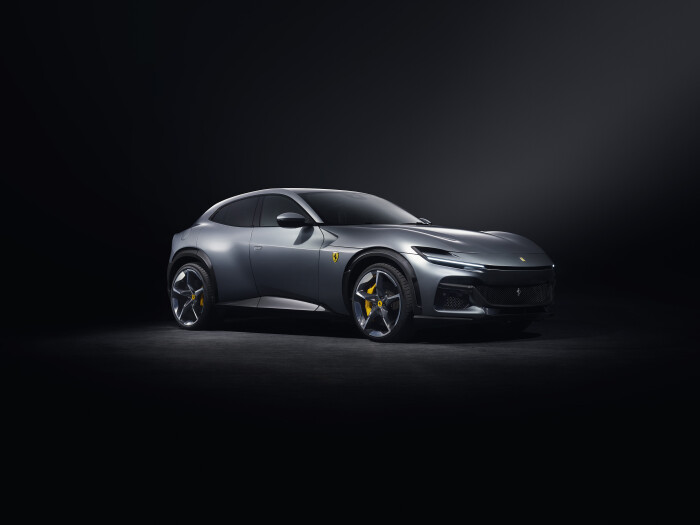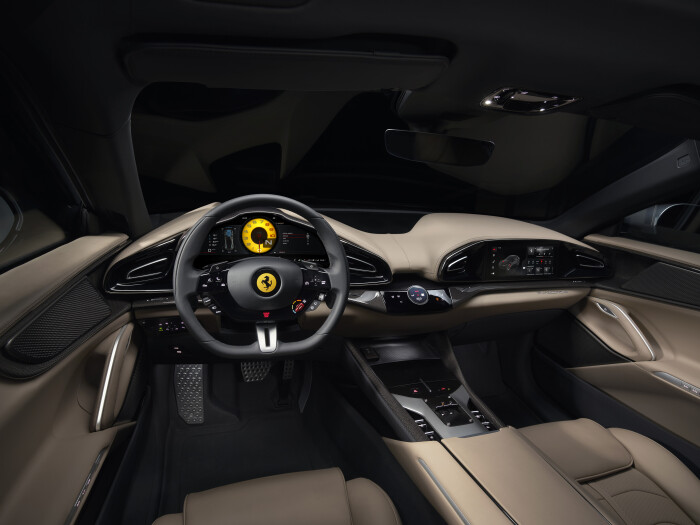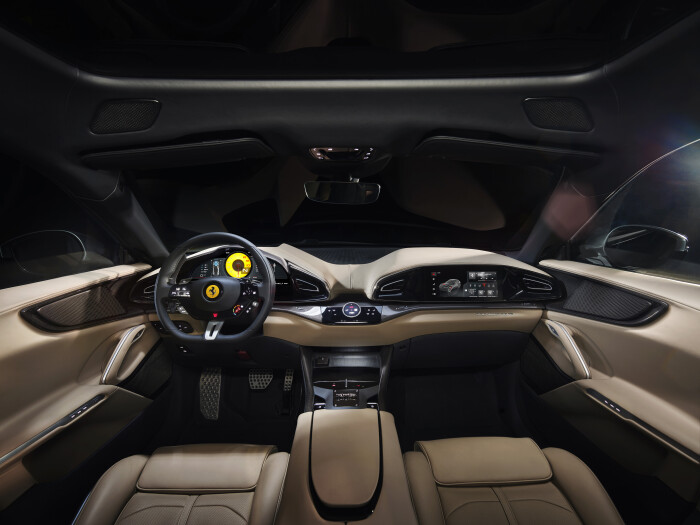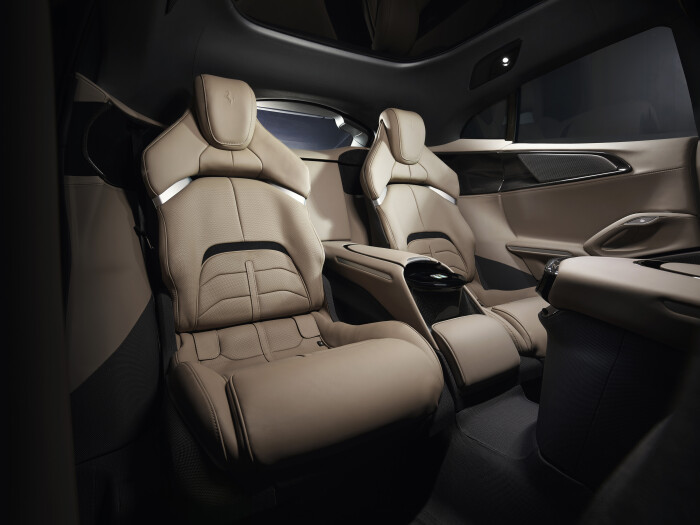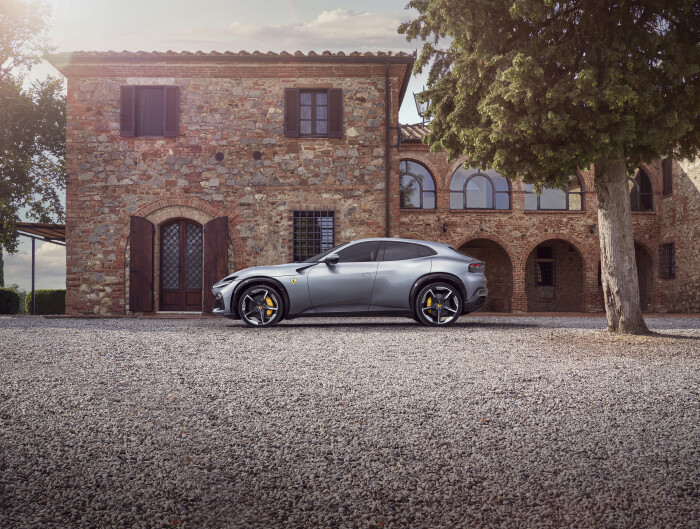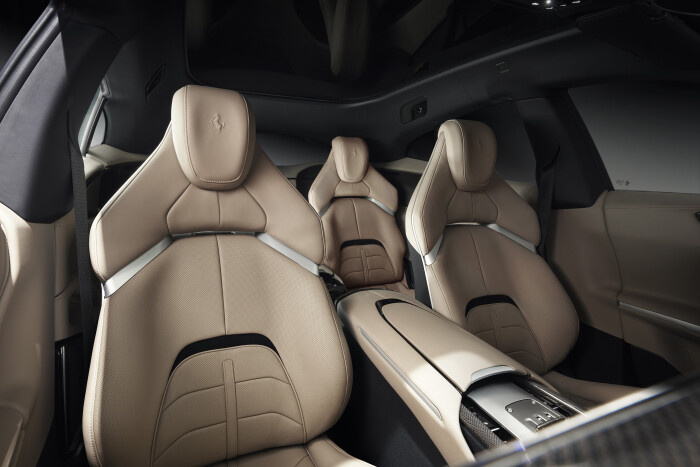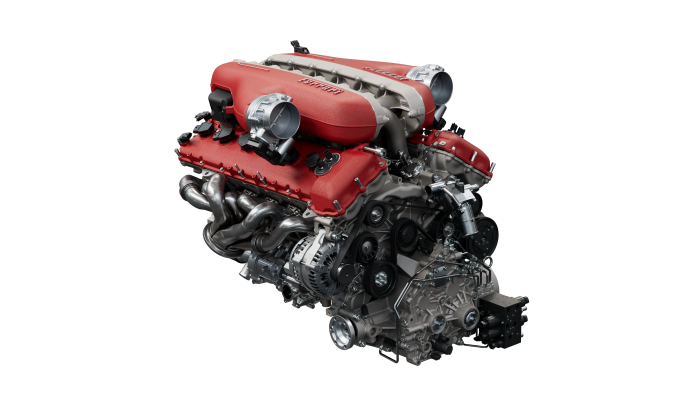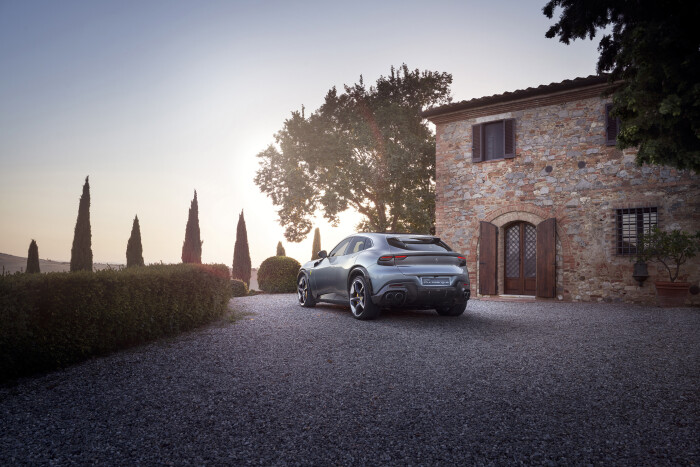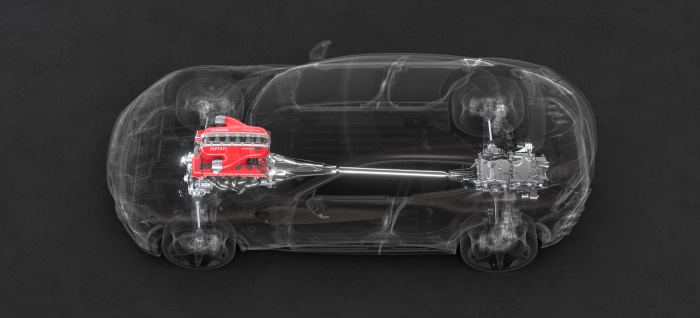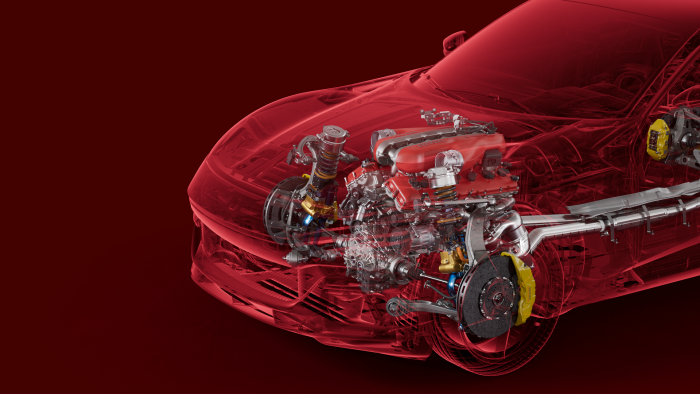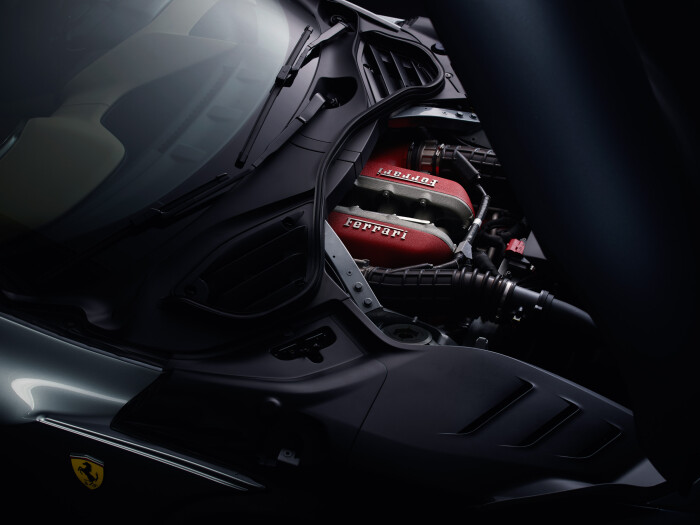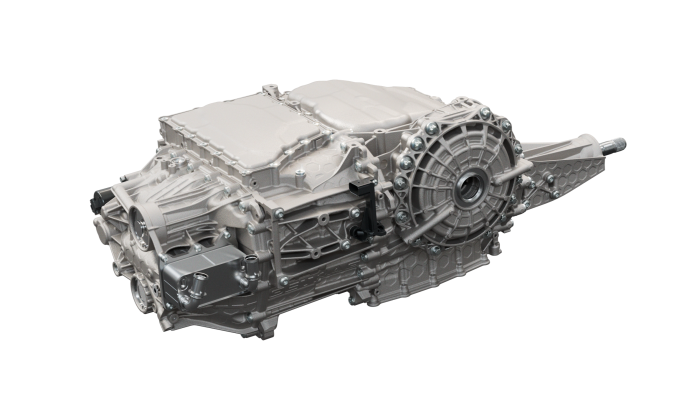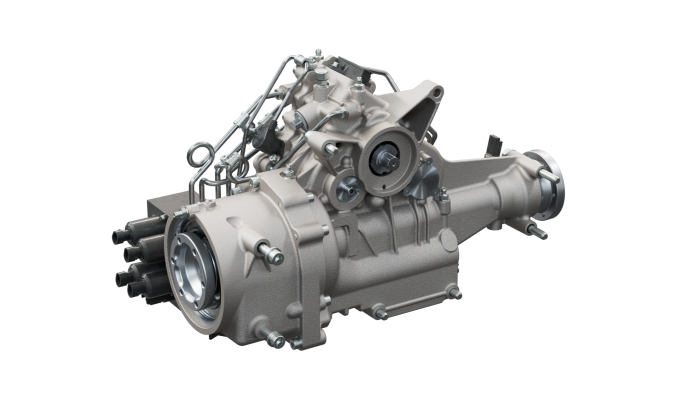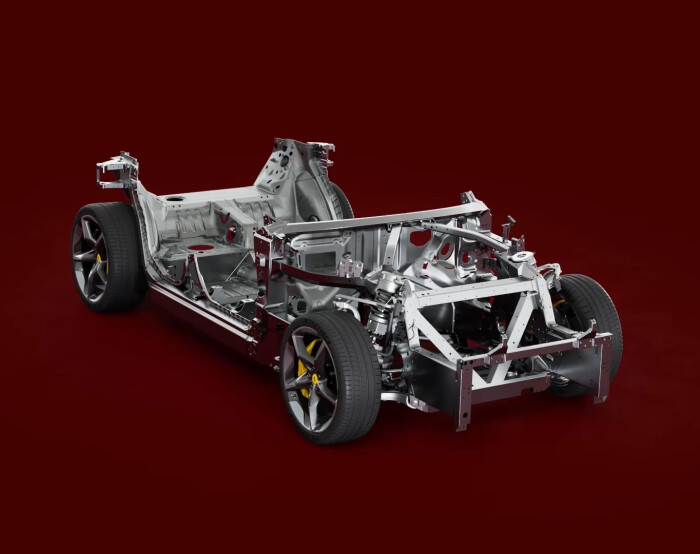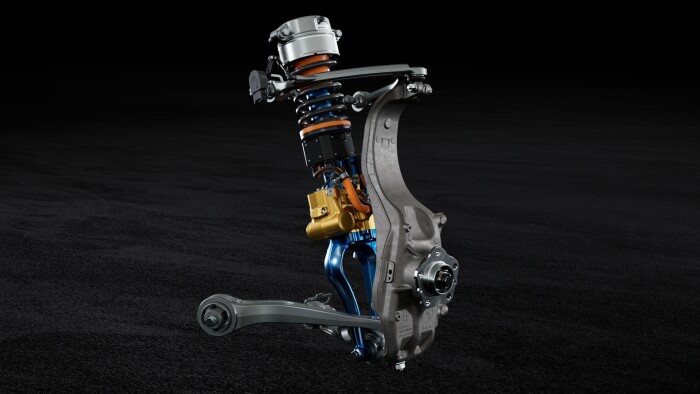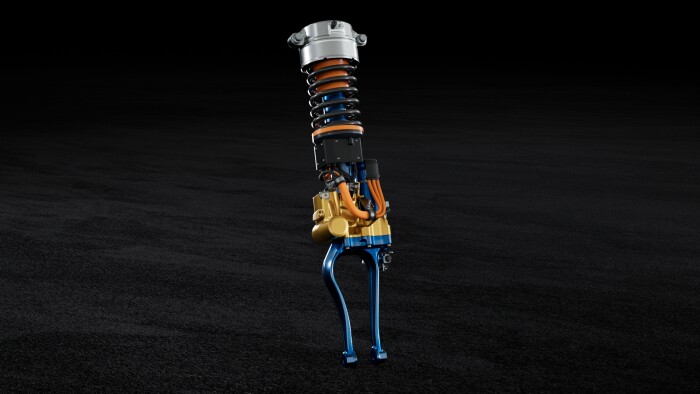• The Ferrari
Purosangue was unveiled today, the first four-seat, four-door car in the history of the Prancing Horse .
of dynamic vehicle inspired by the brand’s super sports cars make the Ferrari Purosangue a true four-door super sports car, for driving thrills in pure Ferrari style
• The innovative architecture of the Ferrari Purosangue, which defies any existing categorization, creates a new standard in the automotive landscape international
Lajatico, 13 September 2022 - At the height of a long wait on the part of the international automotive scene, the Ferrari Purosangue, the first four-door and four-seat car, was presented today in the wonderful setting of the Teatro del Silenzio in Lajatico (Pisa). created by the Maranello company in its 75-year history.
Since the first years of the brand’s activity, 2+ cars (that is, equipped with two front seats and two rear seats, the latter often small in size) have played a significant role in its strategy. In fact, many Ferraris have made the union between absolute performance and first-rate comfort one of their pillars: today, this seventy-five-year research has given life to a unique car in the automotive world in which performance, driving emotions and comfort they coexist in complete harmony, and which at the same time is imbued with the unmistakable DNA of the Prancing Horse.
In order to achieve these ambitious goals and create a car capable of fully fitting into the range of the Maranello company, it proved necessary to equip it with a distinctly different layout and proportions compared to the archetypes that characterize common modern touring cars (the so-called crossovers and SUVs). . These categories are in fact characterized by an engine in a very advanced position, almost astride the front axle, to which the gearbox is adjacent and immediately connected: the suboptimal weight distribution would have led to a driving dynamics and an ability to excite not in in line with the standards of excellence to which the Prancing Horse has accustomed its customers and enthusiasts.
The Ferrari Purosangue, on the other hand, features a sporty transaxle architecture with an engine in a central-front position and a gearbox at the rear, as well as a PTU ( power transfer unit ) connected in front of the engine for an unprecedented 4 × 4 transmission mode. In this way, the car achieves exactly the weight distribution that Maranello engineers consider optimal for mid-front-engined sports cars, namely 49:51.
The car also stands out from any other on the market for its performance and comfort. The Ferrari Purosangue is in fact the only car of these proportions to adopt a naturally aspirated V12 in a central-front position: the most iconic engine of the Maranello company makes its debut in an unprecedented configuration that allows the car to deliver the greatest power in the segment ( 725 cv) associated with the most engaging and representative sound of the brand. Furthermore, it is able to provide 80% of the torque already at low revs, for unique driving emotions in all conditions of use.
The aerodynamic study of the Ferrari Purosangue sought the maximum efficiency of the bodywork, underbody and rear extractor. Among the new solutions, the synergy between bumper and front tail that creates an air curtain to aerodynamically seal the front wheels, thus eliminating transverse turbulence.
The Maranello company has equipped the Ferrari Purosangue with the latest version of the vehicle dynamics systems introduced in its super sports cars, such as the independent four-wheel steering system or the ABS ‘evo’ with 6-way Chassis Dynamic Sensor (6w-CDS ). On the other hand, the Ferrari active suspension system makes its absolute debut in the Ferrari Purosangue, capable of regulating load transfers and roll in curves, as well as contact between wheels and the ground even at high frequencies, to obtain performance and driving feeling that are only comparable. to those offered by the sports of Maranello.
The new frame is equipped with a carbon fiber roof as standard, to reduce weight and lower the center of gravity. The design from scratch of the body made it possible to create a system for opening the rear doors ( welcome doors ), to facilitate entry and exit of the occupants while keeping the Ferrari Purosangue more compact. Inside there are four large heated armchairs with electric controls, able to comfortably accommodate as many adults. The trunk, the largest ever offered in a Maranello car, can be made even more spacious by reclining the rear seats to transport bulky items. Naturally, the Ferrari Purosangue adopts a higher driving position than that of the rest of the range; however, the configuration is the same, so that the driver is close to the floor and is able to feel in direct relationship with the chassis, a necessary condition for obtaining an optimal connection with the dynamic qualities of the car.
The Ferrari Purosangue provides class-leading performance (from 0 to 100 km / h in 3.3 s and from 0 to 200 in 10.6 s); The driving setting and heady sound of the naturally aspirated V12 create a driving experience like no other, yet distinctly Ferrari. The standard equipment of a wide range of comfort contents (among which the Burmester® Hi-Fi system stands out) and the numerous optional equipment available, such as the brand new Alcantara® coating from certified recycled polyester, make it the most complete four-door, four-seat car on the market.
MOTORPROPULSER
The engine of the Ferrari Purosangue (code F140IA) has been designed to ensure maximum torque available from low revs without sacrificing the continuous progression characteristic of the naturally aspirated V12s from Maranello. 80% of the torque is available from 2100 rpm. and peak torque of 716 Nm is reached at 6250 rpm; the maximum power of 725 hp at 7750 rpm. and the response to driver inputs are worthy of a sports car. The intake, distribution and exhaust systems have been completely redesigned, while the cylinder heads derive from those of the 812 Competizione. Great attention was paid to improving mechanical and combustion efficiency, using calibration concepts inspired by Formula 1 cars.
The result? The most powerful engine developed by Ferrari for a four-seater car is also the most performing in the segment, as well as the only one capable of giving unmistakable sound. The engine maintains the architecture that has made the success of the most recent twelve aspirated cylinders of the Prancing Horse, including that of the 812 Competizione, i.e. 65 ° between the cylinder banks, 6.5 liters of displacement, dry sump and high pressure direct injection. .
To ensure maximum mechanical efficiency, the rotating masses have been redesigned. In addition to the nitrided steel crankshaft, the stroke of which has been lengthened, both the design of the internal lubrication channels have been optimized, to ensure better feeding of the main bearings, and the coupling clearances in order to improve consumption. The water and oil pump unit has been redesigned, particularly in the part of the recoveries, to reduce friction and masses by reducing the diameter of the rotors of the recovery pumps and the optimization of suction and delivery ports and rotating seals.
The geometry of the manifold and intake lungs has been rethought and optimized, which together with the development of the camshaft profiles has made it possible to obtain a full and continuously increasing torque curve. The exhaust system has also been optimized by improving its permeability and thus reducing its back pressure. The pistons are specific, with a dedicated development of the top, aimed at improving combustion efficiency.
The direct injection system is equipped with two 350 bar high pressure pumps that send the petrol to the injectors directly in the combustion chamber. The system, consisting of twelve coils and spark plugs, is managed by an ionizing current control unit capable of controlling the ignition of the spark in single or multispark mode , in order to maximize combustion efficiency at all speeds. The ECU controls the detonation in the chamber to ensure maximum thermodynamic efficiency of the engine in all driving and environmental conditions and is also able, thanks to a sophisticated recognition strategy, to determine the quality (RON) of the petrol in the tank and to adjust the advance.
The engine calibration also integrates a new patented feature, derived from the experience in Formula 1, which allows to optimize the value and shape of the engine torque during acceleration transients from low and medium revs.
The sound of the F140IA engine is an excellent example of the integration between the symphony of the cylinder combustion sequence and Ferrari’s ability to master the acoustics in the cockpit. The exhaust manifolds, all of the same length, are tuned in such a way as to make the harmony of the twelve cylinders perfect; the new lung with optimized intake conveyor accompanies the high notes of the V12 with the midrange body; and the two silencers with progressive attenuation, whose response is now included in the Manettino’s strategies, give the car maximum versatility. The resulting sound is typically Ferrari, with the unmistakable harmony of the V12 orders that gently accompanies the driver until he accelerates decisively: that’s when the 8250 rpm.
The layout of the double-clutch gearbox and 8-speed in oil bath has been optimized through the adoption of a dry sump and the significant compacting of the clutch unit, which has made it possible to reduce the installation height in the car by 15 mm with relative lowering of the center of gravity. The new clutch improves performance by 35% for dynamic shifting torques up to 1200 Nm. Thanks to the new generation actuation hydraulics, clutch filling times are reduced by 30%. Total shift times are thus reduced compared to the seven-speed DCT. The shifting of the Ferrari Purosangue is characterized by a feeling of short ratios, which is flanked by the last longer which rewards autonomy in highway driving conditions. The downshifts have been calibrated by favoring fluidity, driving emotions and exaltation of the engine sound.
FRAME AND BODY
The completely new chassis of the Ferrari Purosangue was designed starting from a white sheet in order to obtain a structure with excellent torsional rigidity; made entirely of high-strength aluminum alloys, it takes advantage of Ferrari’s enormous experience in the use of such lightweight materials. Together with the structural elements of the body, it forms a structure composed of closed section extruded profiles, connected by fusions, to which the load-bearing elements in sheet metal are integrated.
The chassis thus designed has a reduced weight compared to that of the other four-seater cars of the Maranello company, despite its larger dimensions. The improvement of torsional (+ 30%) and flexural (+ 25%) stiffness were fundamental to improve the level of vibration and acoustic absorption of road bumps, as well as giving a solid and stable driving sensation.
The extensive use of thin-gauge hollow castings, obtained through the use of internal cores, has contributed to optimizing the structure and maximizing its performance, as well as ensuring greater continuity of the load lines for maximum occupant safety. The use of this technology also ensures greater integration between the components, reduces their number and consequently also reduces the welding lines.
The shell was made of materials ranging from aluminum to carbon fiber, introducing high-strength steel in the key points and adding structural bonding to the mechanical joints. By combining very different materials, the maximum resistance of the structure is guaranteed where necessary, while lightening it in areas not subjected to stress. High-strength steel is used on the anti-intrusion bars, the reinforcements of the main nodes and the central post. The maniacal level of detail of the design is evident from the use of different materials even in the creation of a single component, such as the single hinge of the rear door: the fixed part is in aluminum alloy, while the moving part is a molded part. hot in steel.
The roof, a carbon fiber monocoque with drowned soundproofing, is completely new and has a stiffness equal to that of a glass pavilion, in addition to a weight of 20% less than an aluminum one with soundproofing. From an ergonomic point of view, maximum space for entering the car is offered, while maintaining a contained wheelbase, by opening the front doors at 63 ° (+ 5 ° compared to the rest of the range) flanked by two new rear doors with electric opening upwind at 79 °. This system, which recalls the opening of the bonnet of the Ferrari Monza SP1 / SP2 and other legendary Ferraris of the past, allowed the Maranello engineers to design more extreme shapes in the A-pillar area. The gooseneck hinges, made of aluminum,
The tailgate is equipped with electric opening through 2 stabilus that allow it to open at 73 °, in order to facilitate access to the trunk and to be able to easily load even the most voluminous luggage. Finally, the gooseneck hinges made it possible to create unconventional shapes also in the area of the upper spoiler.
AERODYNAMICS
The volumes and constraints of a unique product such as the Ferrari Purosangue have meant, for the aerodynamics department of Maranello, the adoption of innovative methods and solutions. The extremely ambitious targets of reducing aerodynamic drag, habitability, usability and cooling of the powerful V12 and ancillary systems required hundreds of hours of development in the wind tunnel and thousands of CFD simulations, a time comparable to that spent on Ferrari super sports cars.
The starting point was the design of the car’s centerline section, essential for designing the flows, reducing its Cx and minimizing the front surface seen from the air. The front part of the silhouette gives great continuity to the front area of maximum curvature of the bonnet with respect to the crosspiece of the windshield. The rear of the roof, rear window and spoiler required a lot of work, as these are key sections for managing flow separations and pressure fields.
The optimal compromise between the soft lines that characterize the roof-rear window and the need to reduce the height of the transom has been achieved through two elements that complete the aerodynamic design of the rear, namely the suspended spoiler and the nolder a hood end. The former helps to neutralize the curvature of the roof downstream of the rear occupant space, while the latter (just 7 mm high) guides the vortexes ensuring a slight recompression at the rear.
Moving from the center section towards the rear, notice the shell that begins at the end of the roof and extends to the rear window generating two lateral ridges. This solution maximizes the habitability in the rear compartment and at the same time keeps separate the flows coming from the upper part of the roof and those that touch the glass surfaces.
The management of the turbulent wake of the wheels is also of great importance: for this purpose, aerodynamic solutions integrated in the floating tailpieces of the wheel arches have been implemented. The more complex system, however, is found at the front, where the bumper and tail end cooperate to generate an air curtain that aerodynamically seals the front wheels, preventing the creation of transverse turbulence. In fact, an air duct has been created between the front bumper outside the side air intakes and the vertical fin that closes the frame of the mouth to accelerate the flow towards the blowing in the tail piece and release a tangent air blade. to the outer shoulder of the tire. Its external surface, on the other hand, guarantees the correct orientation of the flow towards the side.
A profiled duct has been created on the back of the tail piece to widen the extraction of air from inside the wheel arch. The same solution is also found in the bottom of the tail of the rear wheel arches. The extraction of air from the rear wheel arch is also entrusted to an opening on the rear of the tail, while the profiled external surface optimally manages the rear detachment point of the flow that touches the side and the wheels.
The wing suspended on the front bonnet in front of the ‘A’ pillar of the Ferrari Purosangue, defined aerobridge by analogy with a similar element introduced on the F12, nevertheless performs different functions compared to its counterpart: that of the Ferrari Purosangue, in fact, does not direct downwards the flow coming from the hood to increase the vertical load, but instead aims to reduce the drag.
Under the wing on the hood, the flow is energized to reduce the negative local effects of the vortex at the base of the windshield and speed up the fluid flow thus increasing the air flow of an evacuation hidden from the wing of the aerobridge . This element is part of a complex system of air ducts which has its entrance in the intake located above the projector. The air mass is then conveyed to the front wheel arch. The air flows coming from the front of the car find a natural way of vent in the louver of the upper part of the wheel compartment, then continuing inside the engine compartment to reach the exit under the aerobridge . Similarly, to reduce overpressures at the rear, a duct outlet was created under the headlight, the entrance to which is in the rear wheel compartment.
The blowing towards the bottom present in the lower part of the front bumper allows to reduce the areas naturally in compression, maximizing the flow towards the bottom. The element is present on other Maranello cars, but on the Ferrari Purosangue it is used differently: the energy flow channeled on the bottom by the blowing meets the underbody surfaces designed to generate aspirations near the evacuation of the central radiators present on the front bottom. The cooling efficiency of the central radiant masses was thus maximized and, therefore, a narrower inlet to the radiators was designed. The considerable ground clearance of the Ferrari Purosangue means that the exposed part of the wheels makes a significant contribution to resistance:
In the Ferrari Purosangue, the curves of the body surfaces have been designed in such a way as to shield the front wheels and suspension arms and thus limit the entry of air into the wheel well; to this end, the small deflector mounted on the lower arm of the suspension is decisive. The low-pressure areas behind the front wheels have been exploited to create two vents which, by reducing overpressures in the engine compartment, increase the efficiency of the radiant masses with beneficial effects on the car’s resistance to rolling.
The design of the rear diffuser is the result of a profound optimization work that has above all taken care of the synergy between the diffuser itself, the body and the rear bumper. The air flow that affects the diffuser is expanded in a gradual and controlled way; at the end of this expansion an almost imperceptible nolder forces the detachment of the flow after a slight recompression. This increases the efficiency of the system by maximizing the extraction of hot air from the interior.
The vehicle is not equipped with a rear window wiper, therefore cleaning is entrusted to the air flows that lick the glass surfaces. In the lower part of the suspended spoiler there is a curved surface which guarantees the correct speed and direction of the air flow. On the external parts there are two pairs of vortexers that guarantee the uniformity of the cleaning action, acting in opposition to the vorticity naturally introduced by the ‘C’ pillar and in synergy with the particular shape of the rear window.
The unconventional positioning of the front headlight made it possible to create two air inlets above and below the DRLs. The upper one is used to power the blower system below the front aerobridge , while the lower one feeds the brake cooling system. An air-catcher has been introduced on the external walls of both intakes which increases the air flow.
On the lower part, on the other hand, there are the outlets that serve the radiant masses. On the left there is the radiator of the active suspension circuit, while on the right there is the PTU radiator, responsible for the distribution of the engine torque ( torque vectoring ). Finally, the central vent allows the cooling of the oil and water radiators of the iconic aspirated V12 and of the condenser of the air conditioning circuit, to ensure maximum comfort in the cabin.
VEHICLE DYNAMICS
The development of the dynamic performance of the Ferrari Purosangue focused on the creation of a new car in the world automotive scene, equipped with standards of usability and comfort at the top of the market as well as dynamic and performance characteristics markedly Ferrari and comparable to those of the other range cars. .
The Purosangue boasts a unique and innovative system worldwide: the Ferrari active suspension system, which uses Multimatic’s TASV (True Active Spool Valve) technology. Compared to other solutions on the market, this new architecture offers numerous advantages by combining the drive of an electric motor with a high-precision hydraulic shock absorber in a single fully integrated system. The electric motor ensures active control of the body and wheels with greater precision and at higher frequencies than traditional adaptive or semi-active systems.
An advantage of this system is the speed at which the 48 volt TASV motor actuators apply force in the direction of the shock absorber stroke. The high-density three-phase brushless electric motor, developed specifically by Ferrari, uses slotless stator winding technology to minimize radial dimensions and maximize power density. Mechanically, the force of the motor is transmitted in an innovative way through a ball screw connected directly to the stem of the hydraulic shock absorber, which allows a high frequency response and reduces friction, inertia and encumbrance.
The active suspension system uses accelerometers and position sensors on each of the four suspensions and interfaces with the Side Slip Control (SSC) 8.0 and the 6w-CDS sensor. Ferrari’s proprietary control logic, together with the TASV shock absorbers supplied by Multimatic, electronically manages every performance element of the fully active suspension system.
This technology optimizes maximum cornering performance thanks to the variable and continuous distribution of roll stiffness and active roll center lowering (reduced by up to 10 mm), benefiting the lateral force acting on the tires and the balance between oversteer. and understeer. The high-frequency control regulates both body and wheel movement, thereby reducing roll and pitch and absorbing road surface irregularities.
In addition to the active suspension system, the Ferrari Purosangue boasts a new semi-virtual front suspension archetype consisting of a lower arm with two attachment points on the hub carrier. The lower virtual hinge is very close to the wheel center, which significantly reduces the distance between the intersection point of the steering axle extension with the ground and the center of the tread. This outlines a lesser sensitivity of the steering wheel to road irregularities and braking.
The Ferrari Purosangue is equipped with the new ABS ‘evo’ developed in co-design with Bosch®, implemented in the brake by wire system and introduced for the first time on the 296 GTB. On the Ferrari Purosangue, in particular, the management of low-grip bottoms in all positions of the Manettino was perfected, thus optimizing its performance and repeatability in all conditions. This system uses the information coming from the ESC ( Electronic Stability Control) in order to obtain an accurate estimate of the speed and decide the optimal slip of each wheel under braking. This makes it possible to make the most of the longitudinal force of the tires, while the accuracy of the estimates maximizes the repeatability of the maneuver, reducing dispersions due to natural variables, including asphalt conditions.
The EPS-based grip estimation system developed for the 296 GTB has also been optimized and extended to operate on snow-covered or very low-grip surfaces. By exploiting the information from the control unit and the attitude angle value estimated by the SSC 8.0, this logic is able to calculate the level of grip that characterizes the contact between the tire and the road during steering. This approach allows a precise estimate even in driving conditions that are not at the limit and speeds up the self-learning of the real grip , to the benefit of the estimation accuracy in all grip conditions.
The 4WD-S all-wheel drive system introduced on the Ferrari GTC4Lusso finds its natural evolution on the Ferrari Purosangue, inheriting both the innovations developed for the four-wheel drive system of the SF90 Stradale, and the new independent four-wheel steering system (4WS) of the 812 Competition. Yaw handling when cornering under acceleration is ensured by the combination of torque vectoring on the front axle, the E-Diff’s torque distribution and the lateral force generation of the 4WS system. The new electronic management makes it possible to obtain a significant increase in performance in terms of precise control of the position requested by each actuator, reduction in the response times of the axis and increase in precision in creating lateral force.
All the technologies described above are part of version 8.0 of the Side Slip Control system which provides the controllers with a common language to identify the best way to maximize performance. In fact, the SSC 8.0 integrates the controllers present on the vehicle (steering, driving torque and vertical control) active on the four corners of the car and creates natural synergy with the new ABS ‘evo’.
The objectification of driving emotions in the longitudinal phase has also been calibrated to the performance targets of the Ferrari Purosangue: the traditional values of increasing acceleration and reduced response time are joined by resumption in gear with manual gearbox to emphasize elasticity and recovery qualities, which are fundamental. for this car.
The car is equipped with the eight-speed DCT gearbox, which exploits its potential from all points of view: mechanical, energy and control. The ratios are the same as those of the SF90 Stradale and the 296 GTB; despite the larger tire size, this allows the Ferrari Purosangue to have shorter ratios on average than the previous four-seater of the brand, as well as a smoother progression. The presence of the last gear favors autonomy on the motorway. The software control system of the gearbox benefits from a reduction in shift times of approximately 18% and from the sailing function , which automatically decouples the engine and gearbox where driving torque is not required, therefore also during braking, in favor of greater smoothness.
As for the driver assistance systems (ADAS), the Ferrari Purosangue comes with a considerable portfolio of standard contents, many of which developed in collaboration with Bosch®, including Adaptive Cruise Control (ACC), Automatic Emergency Brake System ( AEB), Auto High Beam (HBA / HBAM), Lane Departure Warning (LDW), Lane Keeping Assist (LKA), Blind Spot Detection (BSD), Rear Cross Traffic Alert (RCTA), Traffic Sign Recognition (TSR), Driver Drowsiness and Attention (DDA) and rear parking camera (NSW).
Finally, for the first time on a Ferrari, HDC ( Hill Descent Control ) is available, which allows you to maintain the speed set on the dashboard display even on downhill roads. When the function is activated, the car works together with the braking system to prevent the speed from exceeding the value set on the display. HDC can be manually deactivated at any time by pressing the accelerator pedal.
STYLE
The Ferrari Purosangue creates a new market segment in which the Maranello marque opens up totally new scenarios. Thanks to its modern and unique architecture, it represents a versatile car, able to combine unparalleled comfort with performance and driving emotions typical of every Ferrari. Transposing the DNA of the Prancing Horse onto an innovative car for the brand and for the entire world automotive scene represented a stimulating challenge for the Ferrari Style Center, directed by Flavio Manzoni.
The definition of ‘Purosangue’ is well suited to the architecture of the car: the athletic and slender exterior, which distinguishes it from the four-door, four-seat cars on the market, and the naturally aspirated V12 engine in the central-front position. to a luxurious, comfortable cabin with a high degree of habitability. It is a very agile, snappy car, but it is also the first four-seater Ferrari, whose volume allows it to offer exceptional comfort conditions to all occupants.
EXTERIOR
The car body of the Ferrari Purosangue, developed by subtracting volumes, is split into two levels; a lower one represented by the underbody, more technical, and a sinuous and powerful upper one. This division is emphasized by the floating effect of the upper volume, which seems almost suspended on the wheel arches.
Although the volume is more impressive than that of a super sports car, the particular scanning of the car in height produces an overall effect of lightness. At the same time, to give the Ferrari Purosangue a marked posture, the Centro Stile has preferred the search for bold and original shapes.
The shape of the Ferrari Purosangue was conceived as a sculpture that enhances aerodynamic research; Proof of this is the wide range of crossings that characterize it, for example the pontoon effect of the front fender that creates a bridge between the front and the side. Each aerodynamic element is an opportunity to give the shape a sculptural and original effect, underlining the stylistic code of the car. The concept of lightness and compactness is also applied to the roof, whose characteristics are emphasized by the powerful rear fenders, which give unique proportions to the silhouette of the car.
The front is in continuity with the side of the car and develops on levels that favor a dynamic horizontal reading. The Ferrari Purosangue does not have a grille, replaced by a dihedral suspended on the lower part, which is more technical. Two shells generate a kind of suspended disc in which a groove houses the camera and parking sensors, integrating them perfectly into the shape of the car. At the ends are the DRLs, each of which is set between two pairs of air intakes that flow into the upper part of the side, reinforcing the style theme. This interpretation means that the look of the front of the Ferrari Purosangue is born from an aerodynamic blow, rather than from visible headlights.
The upper section of the disc is supported by an element composed of a central area that cools the engine compartment and two side cheeks that surround the central splitter . Above the escape develops the long sculpted hood, characterized by rounded muscles ending with wing surfaces. Two suspended fins bring the bonnet and side into continuity.
The sides are characterized by an air passage under the hood that runs sideways, outlining the main theme of style, and generates a dihedral that ends on the powerful rear muscles. The wheel arches under the fenders reveal the second skin of the Ferrari Purosangue: the functional and technical elements are captured in second reading and the car is thus perceived almost as a suspended coupe. The folding opening of the doors makes one perceive from the outside a very large internal volume compared to that which can be guessed when the car is closed, thanks to the meticulous work to contain the proportions of the pavilion.
The posterior muscles fade to the tail, under which the transom develops. A horizontal escape welcomes the optical groups at the ends. Under the lights, two emptyings converge in as many air outlets. The rear develops in width thanks to an imposing diffuser and the large muscles of the fenders, on which rests a sports cabin whose compactness was central to giving the car a sporty bearing without sacrificing its habitability. The passenger compartment is characterized by a sloping windshield and front pillar arches that converge on the rear spoiler, under which an aerodynamic blow leads to a rear window characterized by two very marked ridges.
Specific forged wheels have been studied for the Ferrari Purosangue based on an aerodynamic concept similar to that of the SF90 Stradale, in which the deflectors distributed in the channel facilitate the extraction of hot air from the wheel arches. These aerodynamic appendages develop on three-dimensional surfaces emphasized by an elegant diamond treatment.
INTERIORS
The interior of the Ferrari Purosangue required a meticulous design of spaces and furnishings and a careful selection of materials, to ensure unprecedented habitability on a four-seater from Maranello. The interiors are presented as a sporty and elegant lounge. When you open the doors from the outside you are surprised by the amount of space present, but also by the sophisticated luxury that expresses refinement and modernity. Modern languages harmoniously combine with the typical sport touring sensation of the Ferrari tradition. To make the most of the space on board, all the shapes have been designed to ensure minimum dimensions, obtaining maximum ergonomics.
The driver’s seat is inspired by that of the SF90 Stradale and finds its almost symmetrical alter ego on the passenger side. This creates an unparalleled emotional involvement for the front passenger, thanks also to the 10.2 ”display that allows you to get all the information you need to participate in the driving experience. The Ferrari Purosangue is also equipped with the full-digital interface already introduced in the rest of the range.
The entire architecture of the Ferrari Purosangue is based on the concept of a double cockpit dashboard, extended in a specular way to the rear area to create four distinct areas in functional, volumetric, material and chromatic terms. This principle guided the composition of the passenger compartment, developed according to a horizontal reading and without interruption between the furnishings, which allowed to increase the perceived space and to preserve dynamic and light volumes.
The enveloping shapes that converge towards the center embrace the occupants and, through the dialogue between saddled volumes and functional technical areas, enhance the concept of double cockpit at the front and rear. The central area of the dashboard houses the controls related to comfort, controlled via a retractable rotary interface also present in the rear area.
The body of the tunnel, finished with fine upholstery, is combined with a structural element dominated by the metal gate with the characteristic ‘Y’ shape. The second reading elements, on the other hand, are the glass opening / closing keys, the double and elegant glass cup holder and the key seat combined with the area for wireless charging of mobile devices. The lower area houses small storage compartments and creates material and chromatic continuity with the bottom. The cockpit extension elements, with their iconic shell shape, integrate and highlight the most performing audio system ever offered by Ferrari. The saddled areas dedicated to comfort, on the other hand, integrate armrests and grab bars.
For the first time in Ferrari history, the interior houses four separate and independently adjustable seats. The integration of components dedicated to comfort, the use of variable density foams and the new spring system have made it possible to achieve an unprecedented level of comfort and a configuration that communicates the sportiness and elegance typical of the Ferrari language. The heated rear seats are independently adjustable and reclining; in an inclined configuration they generate a single plane with the boot compartment, considerably increasing the load capacity.
However, the pursuit of luxury cannot ignore attention to environmental sustainability. The Ferrari Purosangue makes extensive use of eco-sustainable materials that open up to new combinations. 85% of the car’s launch upholstery is produced in eco-sustainable materials: the pavilion fabric is in recycled polyester, the regenerated polyamide carpet is made from fishing nets recovered from the sea and a new composition of Alcantara® also from recycled polyester. The Ferrari Purosangue is in fact the first car in the world to use a special version of Alcantara composed of 68% post-consumer recycled polyester. For this version, Alcantara has obtained the Recycled Claim Standard (RCS) certification from ICEA,
Instead of the traditional carpet or leather covering the carpet, a fabric also used for military clothing is available upon request due to its exceptional strength and durability. A new dark brown semi-aniline leather was then introduced, very elegant and contemporary. Finally, the new carbon fiber weave with copper inserts, available on request, provides an even more elegant interpretation than traditional carbon fiber.
The high-quality standard Burmester® Hi-Fi system also makes its entry into the Ferrari range, capable of guaranteeing exceptional performance from high to low frequency ranges thanks to the introduction of innovative technologies. The ribbon tweeter, making its debut in a production vehicle, and the subwoofer installed in an enclosed housing reproduce high frequencies with unprecedented brilliance, power and speed, as well as breathtaking bass. The 3D sound and the additional configurations offered ensure an immersive, exciting and top quality sound experience that reflects the unique character of the car, and therefore the essence of the automotive masterpieces made in Maranello.
The launch color Nero 75, designed specifically for this car, is equipped with pigments which, in particular light conditions, create very intense red reflections that enhance the volumes of the car.
OPTIONALS AND CUSTOMIZATIONS
The Ferrari Purosangue is equipped with a wide range of optional content and customizations that allow every Ferrari driver to find their own personal balance between comfort and performance. In addition to a wide choice of interior and exterior colors, including some specific and dedicated to the model, innovative solutions have been introduced for the Ferrari range or for the market as a whole.
For the first time on a Ferrari, the possibility of customizing the roof of the passenger compartment with a glass roof equipped with electrochromic technology, as an alternative to the standard carbon fiber one, is offered. The glass has an electro-sensitive film on its lower surface; when the latter is crossed by the current it changes the level of transparency, for an interior radiated by the sun or to be able to screen the light if necessary.
The massaging front seats, made with 10 air pockets, allow a relaxing and incisive massage divided into five different types and three levels of intensity.
An air quality sensor has been adopted on the Ferrari Purosangue, an absolute preview for the Ferrari range, able to control the air outside the car and improve the quality in the passenger compartment thanks to intelligent management of air recirculation. and the use of filters that block particles up to PM 2.5.
Enabling the Android Auto and Apple CarPlay systems, which replace the traditional navigation integrated in the car, is also standard for the first time.
7 YEARS OF MAINTENANCE
The incomparable quality standards achieved and the great attention to the customer are the basis of Ferrari’s seven-year extended assistance program, also offered on the Ferrari Purosangue. This program, valid for the entire range, provides for coverage of all routine maintenance for the first 7 years of the car’s life. The routine maintenance plan represents an exclusive service for customers, who will be sure to maintain the level of performance and safety of their car over the years. This special service is also reserved for those who buy a Ferrari that is not first registered.
The main advantages of the Genuine Maintenance program include scheduled checks (at intervals of 20,000 km or once a year with no mileage limits), original spare parts and accurate inspections using the most modern diagnostic tools by qualified personnel trained directly at the Ferrari Training Center in Maranello. The service is available in all markets and concerns all points of sale of the official network.
Thanks to the Genuine Maintenance program, the wide range of after-sales services offered by Ferrari is further extended to satisfy customers who wish to keep the performance and excellence that distinguish the cars manufactured in Maranello unchanged over time.
